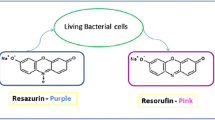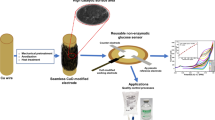Abstract
A conventional Clark-type O2 probe was used to determine N2O concentrations in suspensions. At a polarizing voltage of−0.95 V versus the reference Ag/AgCl electrode, the probe is almost half as sensitive for N2O as for O2, and the detection limit is less than 1 μM N2O. The probe can also be used to determine NO for which the suitable polarizing voltage is−0.7 V. The method was successfully applied for continuously recording dissimilatory formation or utilization of N2O by intactAzospirillum brasilense Sp 7, NO production by extracts from this bacterium, and N2O reduction catalyzed by nitrogenase in intactKlebsiella pneumoniae. It is concluded that the probe is useful for measuring N2O or NO contents in bacterial suspensions when the O2 level is zero or kept constant during the assays.
Similar content being viewed by others
Literature Cited
Bergersen FJ (1980) Measurement of nitrogen fixation by direct means. In: Bergersen FJ (ed) Methods for evaluating biological nitrogen fixation. New York: John Wiley, pp 65–110
Bothe H, Klein B, Stephan MP, Döbereiner J (1981) Transformations of inorganic nitrogen byAzospirillum spp. Arch Microbiol 130:96–100
Dalton H (1980) The cultivation of diazotrophic microorganisms. In: Bergersen FJ (ed) Methods for evaluating biological nitrogen fixation. New York: John Wiley, pp 13–64
Delwiche CC (1981) Denitrification, nitrification and atmospheric nitrous oxide. New York: John Wiley, pp 1–286
Hanus FJ, Carter KR, Evans HJ (1980) Techniques for measurement of hydrogen evolution by nodules. Methods Enzymol 69:731–739
Hardy RWF, Knight E Jr (1966) Reduction of N2O by biological N2-fixing systems. Biochem Biophys Res Commun 23:409–414
Hoch GE, Schneider KC, Burris RH (1960) Hydrogen evolution and exchange, and conversion of N2O to N2 by soybean root nodules. Biochim Biophys Acta 37:273–279
Kim C-H, Hollocher TC (1983)15N-tracer studies on the reduction of nitrite by purified dissimilatory nitrite reductase ofPseudomonas aeruginosa. J Biol Chem 258:4861–4863
Mozen MM, Burris RH (1954) The incorporation of15N-labelled nitrous oxide by nitrogen fixing agents. Biochim Biophys Acta 14:577–578
Neuer G, Bothe H (1982) The pyruvate: ferredoxin oxido-reductase in heterocysts of the cyanobacteriumAnabaena cylindrica. Biochim Biophys Acta 716:358–365
Oehme F, Schuler P (1983) Gelöst-Sauerstoff-Messung. Heidelberg: A Hütting, pp 1–146
Penteado Stephan M, Zimmer W, Bothe H (1984) Denitrification byAzospirillum brasilense Sp 7. II. Growth with nitrous oxide as respiratory electron acceptor. Arch Microbiol 138:212–216
Stephen H, stephen T (1963) Solubility of inorganic and organic compounds, vol 1. Binary systems, parts 1 and 2, Oxford: Pergamon, pp 1–1933
Steudel R, Schenk PW (1975) Stickstoffmonoxid NO. In: Bauer G (ed) Handbuch der präparativen anorganischen Chemie, vol 1. Stuttgart: Enke, pp 470–471
Wang R, Healey FR, Myers J (1971) Amperometric measurement of hydrogen evolution inChlamydomonas. Plant Physiol 48:108–110
Zimmer W, Penteado Stephan M, Bothe H (1984) Denitrification byAzospirillum brasilense Sp 7. I. Growth with nitrate as respiratory electron acceptor. Arch Microbiol 138:206–211
Albery WJ, Brooks WN, Gibson SP, Heslop MW (1979) An electroanalytical method for the determination of N2O. Electrochim Acta 24:107–108
Alefounder PR, Ferguson SJ (1982) Electron transport linked nitrous oxide synthesis and reduction byParacoccus denitrificans monitored with an electrode. Biochem Biophys Res Commun 104:1149–1155
Author information
Authors and Affiliations
Rights and permissions
About this article
Cite this article
Zimmer, W., Danneberg, G. & Bothe, H. Amperometric method for determining nitrous oxide in denitrification and in nitrogenase-catalyzed nitrous oxide reduction. Current Microbiology 12, 341–345 (1985). https://doi.org/10.1007/BF01567894
Issue Date:
DOI: https://doi.org/10.1007/BF01567894




